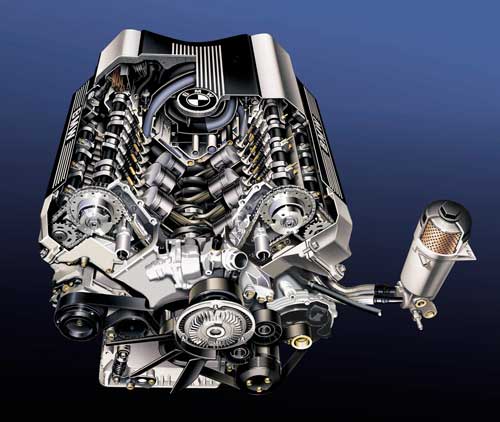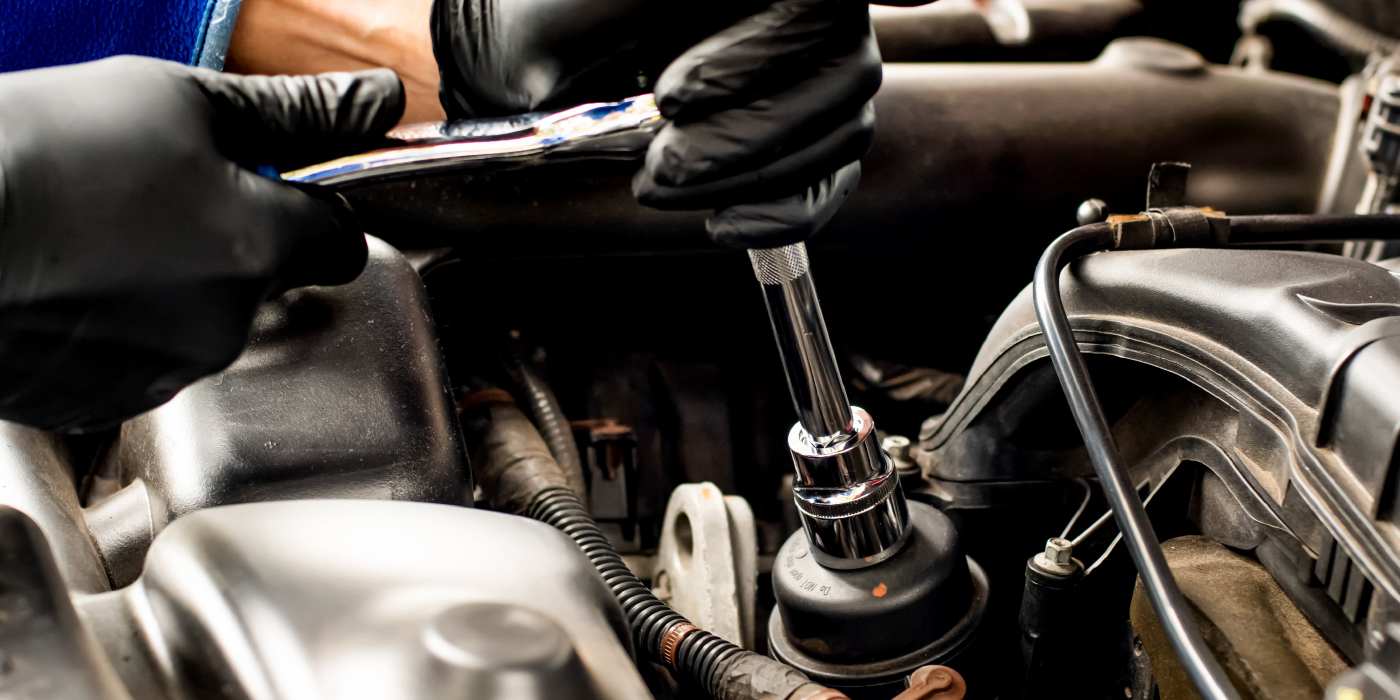
Variable Nockenwellen Steuerung or “VANOS” is BMW’s variable valve timing system. It has unfairly earned a bad reputation for reliability with technicians, but the source of the problem is not the engineering. Rather, it is how some owners push oil intervals and often use low-quality oil.
The latest versions continuously adjust the position of the intake and exhaust camshafts for better power, efficiency and idle performance. The key word to remember for a late-model VANOS system is that it works “continuously” and not just under specific rpm ranges.
Diagnosing a VANOS system does not require that you speak German. What it does demand, however, is knowledge of how the actuator adjusts the camshaft, how the solenoid controls the actuator and when the engine control module changes camshaft timing. As for tools, you will need the appropriate tool set to lock the crank and camshaft. You will also need a scan tool and a scope to observe the crankshaft and camshaft signals to accomplish more advanced diagnostics.
History
VANOS systems have evolved over the past 25 years, from the first single-VANOS systems that were on the intake camshaft of the 1993-1998 engines found in 325i and 525i models. These early VANOS systems could change the camshaft timing by 12.5 degrees for better performance. The first dual or bi-VANOS system was then introduced on the 1996 M3. These systems adjust both the intake and exhaust camshafts. Some newer systems can change the camshaft timing by as much as ±72 degrees.
Later systems, known as Valvetronic, take VANOS to the next level by adjusting the lift of the valves. This system also changes how the engine is throttled, which we’ll discuss later in this article.
When Does VANOS Work?
The early VANOS systems are very basic and work to make more power. Later dual-VANOS systems operate at all engine speeds.
At lower engine speeds, the VANOS system opens the valves later during the intake stroke. This increases the vacuum and scavenging effect generated by the piston traveling downward in the cylinder. This improves idle quality and smooth power tip-in from a stop. As the engine rpm increases, the valves are opened earlier. This enhances torque as rpm increases. At higher engine speeds, the valves open later for full power delivery so the scavenging effect of the exhaust leaving the cylinder can pull more air into the cylinder. Hot rodders call this “valve overlap.”
The system can augment and even eliminate the EGR valve by allowing some of the exhaust gas to remain in the combustion chamber to control combustion temperatures and NOX emissions. Also, the camshaft position is changed to reduce engine warm-up times by allowing some unburned fuel to reach the catalytic converters.
When the VANOS system is not working, the most common symptoms are poor idle quality, reduced power and poor fuel economy. These symptoms are common to any other variable valve timing system.
How Does VANOS Work?
Like many variable valve timing systems, VANOS uses oil pressure-powered actuators to move the camshafts. The actuators need a consistent supply of oil for the correct viscosity, pressure and volume.
Most VANOS systems use a gear on the actuator and a gear on the camshaft that have angled or helical-cut teeth. The timing is changed by moving the depth of the helical gear on the actuator, inside the gear on the camshaft. Connected to the gear on the actuator is a plate or piston with oil pressure on both sides. A solenoid controls oil pressure on either side of the plate to control the depth of the gear.
BMW has used two solenoid designs for dual-VANOS units. For some S54 engines, they use a module with valves that resemble those found in an ABS modulator. The more common design is a spool valve to control the oil on either side of the piston. The solenoid is actuated by a pulse-width modulated signal.
If the oil is contaminated or is the wrong viscosity, the VANOS system can become sluggish. If the oil pressure can’t move the camshafts to the target positions in a specified time, the camshaft position sensors will sense it and set a code. A code will be set if the actuator and camshaft do not return to the correct position, because they are hydraulically jammed due to oil pressure leaking past a seal.
Later engines, like the N54 inline-six, have more common actuators with the chambers inside camshaft sprockets. The same diagnostic basics apply to these systems. But, like helical-gear actuators, they still require a quality supply of oil to operate.
What Goes Wrong With VANOS Systems?
The two most common failures for a VANOS system are related to the quality of the oil.
The helical gears on the actuator and camshaft can wear. This can cause noise and rattle at idle and startup. The most common failure is when the O-ring seal on the piston wears out and allows oil pressure to move between the two chambers.
This causes the actuator to be stuck or hydraulically jammed in either the full advance or retard positions.
When this happens, the gear can’t fight the pressure exerted on the camshaft by the valve springs. This can cause a rattling noise at startup and idle. There are improved replacement seal kits that use Viton O-rings.
The engine control module sees these malfunctions in the data coming from the camshaft and crankshaft position sensors. In some cases, verifying operation with a scope might be necessary.
If the oil is the wrong viscosity, it can cause the corrections to either retard or advance — in other words, to lag or happen too quickly. These changes take place in milliseconds.
Depending on your scan tool and whether you can pull BMW DME or OBDII codes, the description may include the words jammed, stiff or lagging.
The engine will factor in the oil and coolant temperature into the time allowed for the actuation. If you have any codes related to these sensors, you might want to resolve these issues before troubleshooting the VANOS system.
SIDEBAR:
VANOS System Troubleshooting Tips
Oil Matters
Check the condition of the oil system before you attempt to diagnose any VANOS-related problem. The health of the oil directly impacts the VANOS system.
Test the oil pressure to make sure it is within specifications. The problem might not be the VANOS actuators. Instead, the problem could be a worn-out oil pump or larger-than-normal bearing clearances.
If you have codes for a slow or lagging actuator, the solution might be to change the oil. Also, ask the customer when he/she last changed the oil and what was the weight.
Lock it Down
When you are replacing any VANOS actuator, it is critical to lock the camshaft and crankshaft with the correct tool. Just the smallest bump of the camshaft or crankshaft can cause base timing problems when the car is put back together.
Change the Guides
If you are dealing with a higher-mileage BMW that requires VANOS replacement, it might be a good idea to change the chain guides and tensioner. This can prevent the customer from coming back later and complaining about noise coming from the front of the engine.
Don’t Be a Parts Changer
When codes for the VANOS systems are pulled, the first instinct of an amateur technician is to change the solenoid or maybe the camshaft position sensors. About 95% of the time this will not resolve the codes. The problem is typically the VANOS actuator.
Check The TSBs
BMW has issued more than 50 TSBs on VANOS system operation, repair and updated parts. Reviewing these TSBs is time well spent. Also, make sure the system is running the latest calibrations for the DME.
Check the Recalls
On some 2010 and 2011 BMW models with the N51 and N52K non-turbocharged six-cylinder engines, there was an issue with the bolt that holds the VANOS units to the camshaft. The defect could lead to complete failure of the VANOS unit.
BMW extended the limited warranty for the VANOS units to 10 years without a mileage limitation, as determined by the vehicle’s original in-service date.
Check out Campaign SI B01 10 14, for more information.














